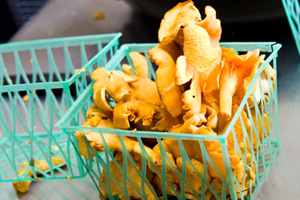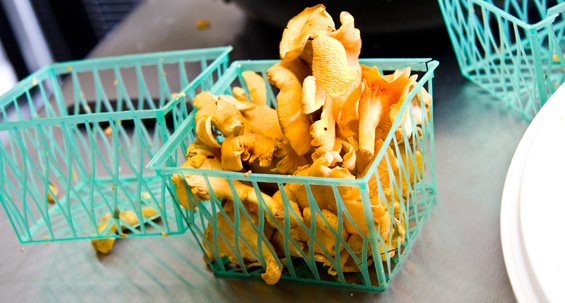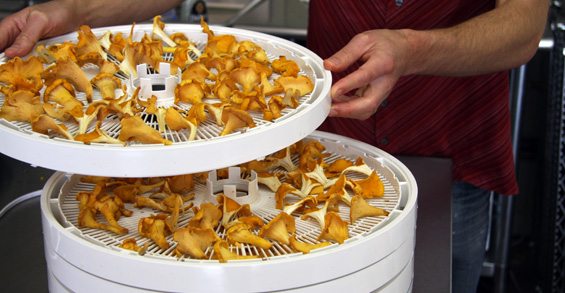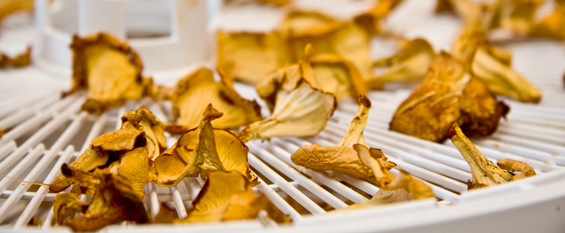Buying fresh mushrooms in bulk and preserving them yourself is a cost-effective way to ensure you have wild mushrooms in your pantry all year long. Below are the methods we prefer for preserving and storing leftover mushrooms:
How to Dehydrate Fresh Mushrooms
If you dry them, they will last for years and retain an intensified form of their intrinsic flavor and vital properties. The best way for most home chefs to dry fresh mushrooms is using an actual dehydrator machine, which dehydrates at a low temperature, better preserving mushrooms’ flavor.
In a pinch you can spread mushrooms on a sheet tray covered with parchment paper in your oven, and bake them at 140 degrees (as low as many ovens will go) until they’ve dried out. However, this isn’t a perfect method because you’re likely to partially-bake your mushrooms while drying them.
How to Prepare Fresh Mushrooms For Drying:
For thinner, smaller varieties like chanterelles, black trumpet mushrooms, and hedgehog mushrooms, you can simply lightly rinse , pat dry, and dehydrate them whole. If you find any particularly large or thick examples you may want to halve them first so they’re similar in size to the others.
Thicker, meatier mushrooms like lobster mushrooms, portabellos, and porcinis should be sliced before drying. We recommend slices that are about 1/4″ thick.
How to Dry Mushrooms in a Dehydrator:
Start your mushrooms out in a dehydrator set very low (80-90 degrees) for the first few hours, then turn the heat up to 120-125 degrees. You shouldn’t need to use any special tray liners, the basic plastic grates work just fine. It could take anywhere from four to eleven hours to dehydrate your mushrooms. We can’t really give you a better estimate than that, because it can vary quite a bit depending on their moisture content, how much you’re drying, and your ambient humidity. A good rule of thumb is to check them every hour or so until they’re starting to dry out, then switch to checking every half hour. They’re done when they’re completely dried out and hard.
Once you’ve established a baseline for your dehydrator, mushroom type & area, you likely won’t need to check as often in the future. If during your checks you notice some of the smaller mushrooms have finished drying ahead of the larger ones, go ahead and remove the dried mushrooms from the trays early, leaving them in can damage their quality.
Store your dried mushrooms in an air-tight container in a cool, dry cupboard. Read How to Rehydrate Dried Mushrooms for tips on making them soft again.
Note: Chanterelles often reconstitute woody, so we prefer to puree them for delicious soups and sauces rather than serving them as whole mushrooms.
How to Freeze Fresh Mushrooms
1. Most varieties you can simply brush off the clinging dirt, but for mushrooms with a lot of nooks and crannies, you might want to give them a gentle rinse, and then carefully dry them as thoroughly as possible.
2. Whether to cut your mushrooms into smaller pieces depends on the size of the mushrooms and your future plans for them. In general, when freezing something the smaller the pieces the better…but if you need them whole or in larger pieces you can freeze them that way.
3. Put a sheet pan in your freezer until it’s good and cold.
4. Place the mushrooms/pieces on the sheet pan in a single layer so they don’t touch each other. Freeze them solid, uncovered.
5. For storage, move the frozen mushrooms to a freezer bag or (even better) a vacuum pack bag. Get as much air out as possible, seal, and keep them frozen until you’re ready to use them.
6. Only thaw mushrooms when you’re ready to use them, as refreezing can damage their flavor/texture.
Note: You can also partially cook (sauté) fresh mushrooms in oil and then freeze them, which will save cooking time later on.
For more info, read How to Freeze Better at Home.
How to Can Fresh Mushrooms
Lastly there is canning mushrooms in oil. Cook down mushrooms in oil and place inside a mason jar, the heat should seal the jar. Keep refrigerated for up to two months!
If anyone has other techniques, please add them in a comment below, or link to your content.
___________
Browse More:
Culinary Techniques
Mushroom Recipes







Comments 38
Pingback: How To Reconstitute Dried Mushrooms | MarxFoods.com Blog
Would like to know how to preserve mushrooms in their natural state without cooking?
Very interesting. I don’t know a thing about how to cook or store mushrooms. This is good for me. I can learn and not ruin anything by seeing what you do and then the recipes people post. And then maybe someday I can make a mushroom dish. Lynn A.
Chanterelles.
I prefer to never dehydrate Chanterelles because they are rather leathery and bland when reconstituted. Instead, clean, slice and then saute the Chanterelles over high heat in butter until they just begin to soften, then remove from heat. When cool, store in weighted portions using food-saver bags and then put them into the freezer. I find 8 oz portions to be an ideal size.
-cheers
when freezing the miataki mushroom, do you rinse/wash, cut/keep whole??
i don’t quite understand. also, can they be frozen in plastic freezer bags? thank you
Hi Eileen,
For freezing mushrooms raw, we recommend this process:
1. Most varieties you can simply brush off the clinging dirt, but as maitakes have a lot of folds, you might want to give them a gentle rinse, and then carefully dry them as thoroughly as possible.
2. Whether to cut or not cut depends on the size of the mushrooms and your future plans for them. In general, when freezing something the smaller the pieces the better…but if you need them whole/in larger pieces you can freeze them that way.
3. Put a sheet pan in your freezer until it’s good and cold.
4. Place the mushrooms/pieces on the sheet pan in a single layer so they don’t touch each other. Freeze them solid, uncovered.
5. Move the frozen mushrooms to a freezer bag or (even better) a vacuum pack bag. Get as much air out as possible, seal, and keep them frozen until you’re ready to use.
6. Only thaw mushrooms when you’re ready to use them, as refreezing can damage their flavor/texture.
For more info, read How to Freeze Better at Home.
Hope this helps!
Matthew
Marx Foods
I have been freezing cutup matsutake mushrooms in water and then vacuum-packing them. Is this okay?
Dear Shiz,
Unfortunately, you’re probably hurting your mushrooms by freezing them that way.
Ice crystals are a major source of freezer damage. The slower food freezes, the bigger the crystals get, poking larger holes in the food’s cell wall. Packing mushrooms in water slows the freezing process and dramatically increases the number of ice crystals.
In addition, the mushrooms will take longer to thaw and likely absorb some of the surrounding water as the ice melts, further damaging their texture and flavor.
Finally, since the purpose of vacuum packing is to prevent the surface of food from coming into contact with air (already being done by the surrounding water) you’re actually wasting your vacuum bags.
Our advice would be to go ahead and chop your mushrooms into smaller pieces, which will help them freeze faster for smaller crystals. Then (ideally) lay the pieces out on asheet tray to freeze before moving to a vacuum bag (for individual pieces that’ll hopefully stand up to the vacuum pressure better). You could also gently vacuum them as a pile of pieces before freezing.
You might even consider trying cooking them or blanching them pre-freeze…which may further improve their thawed texture.
Matthew
MarxFoods.com
Great tips. I think I have the same food dehydrator. I have often seen dried mushrooms at the grocery store but I’ve never thought to do it myself.
I boil them in 1/2 % water 1/2 % vinegar, add garlic oregano, salt basil, and bottle it, seal tight and refrigerate. I have saved for about 3 months, even though I have not preserved them for longer, they should stay in good shape for longer; this of course, is only for harder consistent mushrooms like champignon mushrooms, creminies, baby portobella, etc…. other mushrooms, I put them in olive oil and use the oil to flavor salads or any cooked foods, and sometimes, desserts.
Honey mushrooms found here in southwest Michigan. In Spite of a few huindred recipes aqnd post I have found on the internet I just suated several of the ‘buttons’ in butter until crisp and hey are wonderful. Just my experience and opinion. Harry
is it wise to can sheepshead mushrooms (maitake)? we’ve frozen them in the past but the process leaves them awfully tough. can you can them? pressure canner,etc.
Karyn,
It’s probably ok, but we’ve never done it & don’t know for sure. Let us know how it goes!
Matthew
Marxfoods.com
Great tips on freezing fresh mushrooms, as well as cooking them down and freezing them. I wonder how sautéed mushrooms and onions would be frozen and re-heated. that could be a big time saver.
Thanks,
Steve.
Hi Steve,
We don’t have any experience freezing sautéed onions, but from what I’ve read it can certainly be done. They’re likely to be a little more limp once thawed, so it’s just a question of whether that’s ok with you or not.
Other than that, freezing sautéed mushrooms & onions should work just fine. If you give it a whirl, let us know how it goes!
Matthew
MarxFoods.com
I hear there are issues with blanching/cryo packing & freezing mushrooms, some say it’s not a good idea; does anyone know why that would be??
Hi Eric,
I can’t see why there would be any problem with cryo packing mushrooms. If you’re concerned about the vacuum packing process crushing them, you could blanch, freeze, then cryovac.
If you’re reading things warning against blanching, I have a few theories as to why some people may be warning against it:
One possible reason that blanching mushrooms before freezing is probably controversial is because it involves mushrooms and water. There’s an “old chef’s tale” about mushrooms absorbing water like crazy if it even touches them, which is why really traditional European style kitchens will sometimes use a “mushroom brush” to brush off dirt rather than actually washing them. Generally this isn’t actually a problem unless you’re soaking mushrooms they’re actually mostly water to begin with – a blanch should be pretty quick – you’re just trying to clean the mushrooms and kill enzymes that could degrade them in storage.
Another possible reason is that freezing, in general, will definitely change the consistency of mushrooms, making them softer and more likely to be watery (and best suited to purees, soups, etc). This is why we tend to prefer dried to frozen and some people will tell you that you should never freeze mushrooms in general.
Matthew
MarxFoods
I dehydrate the chanterelles with a new dehydrater I purchased, about 50% more or less, then use a vacuum bag get most of the air out. Then I freeze the vacuum bag with the mushrooms laid out flat, one layer only.
Seems to work pretty good !
Hi Fred,
Thanks for sharing! This is the first we’ve heard of partial-dehydrating before the freeze…but we’re very intrigued…it sounds like it might give even better results. We’ll have to give it a try!
Matthew
MarxFoods
Thank you Matthew!
On my last comment: I just wanted to add that before vacuum you must freeze one layer mushrooms on a pan with waxed paper this way you can vacuum without any moisture going in the vac machine.
Fred,
Thanks for the additional info! We’ll have to give it a try.
Matthew
MarxFoods
My Foodsaver instructions say to never vacuum seal fresh mushrooms, yet you say you freeze them fresh and vacuum seal them. Is it okay since they are frozen first? I’m confused.
Hi Kathy,
Vacuum-sealing fresh mushrooms is very different from vacuum-sealing frozen mushrooms.
I would agree completely with Foodsaver’s directive here about vacuuming fresh mushrooms. Plastic bags are always a bad idea with fresh mushrooms, particularly when vacuum sealing. Mushrooms need to be able to breathe, else their moisture promotes mold/rot and they go bad VERY quickly. We recommend keeping fresh mushrooms in paper bags or boxes or loosely covered with a clean, dry towel.
Mold is not a concern once the mushrooms are frozen. Mold doesn’t like freezer temperatures (and the moisture is all bound up in ice crystals). The primary quality concern when freezing is freezer burn, and the best way to prevent this is to minimize air-exposure via vacuum packing. Also the mushrooms won’t get crushed by the vacuum process once frozen solid.
We’re hoping to add a video to this post soon with more/better mushroom freezing instructions. Stay tuned!
Matthew
Marx Foods
With bulk amounts of fresh mushrooms, we pan roast them all in batches and then chill them well. Then we vac pack them in portioned amounts and either steam or boil the bags for 1/2 hour. That kills off any spore formers and listeria making them safe for long term holding.
Hi Ian,
Thanks for providing a foodservice method and prospective! We appreciate the information!
Matthew
Marx Foods
Can you vacuum can mushrooms in a canister jar and put on the cupboard?
Hi Charles,
I assume you’re talking about fresh mushrooms and using a vacuum device to pull out all the air? If so, I don’t think that will work at all. Vacuum-packing removes the air in a container, but it doesn’t kill bacteria, spores, or other organisms that cause spoilage & food borne illnesses. If you’re combining vacuum packing with some sort of pasteurization process, that might fix the problem, but I’ve never heard of doing so.
In general canning is the least desirable preservation method for mushrooms (compare water-packed canned mushrooms in your grocery store with fresh ones). If you want to preserve mushrooms you can’t eat fresh, drying or freezing is the way to go.
If you’re asking about vacuum packing dried mushrooms on the other hand, you can totally do that, though we don’t consider doing so necessary. A simple air-tight container should keep them in good shape for at least a year, assuming they were dried properly.
Matthew
Marx Foods
i have matsutake for sale if you are interested leave me an e mail please. Thankyou for your time
A friend served mushrooms that were put in mason jar covered in oil. Don’t know if I should sauté first then place in jars cover in oil. What spices should I use if any ? How long will they keep. Ate them with Italian bread. They were delicious. They were oyster mushrooms from a tree..
Hi Carol,
Sauteing would help wake up the mushrooms’ flavor through caramelization, so we’d probably do that (toast any spices for additional flavor too). In terms of what herbs & spices you could use, we’d recommend trying some of these: garlic, chives, lemon zest, marjoram, nutmeg, cloves.
Finally, shelf life can be tricky because of the risk of botulism in some home made items packed in oil. We’d store them in the refrigerator and use them quickly.
Matthew
Marx Foods
1 vote for you! I always buy dried mushrooms at the supermarket but now I can do it myself. Thanks for the post.
I dehydrate the chanterelles with a new dehydrater I purchased, about 50% more or less, then use a vacuum bag get most of the air out. Then I freeze the vacuum bag with the mushrooms laid out flat, one layer only.
Seems to work pretty good !
Very interesting. I think I have the same food dehydrator. I have often seen dried mushrooms at the grocery store but I’ve never thought to do it myself.
These are useful tips to preserve mushrooms for long-term uses in stead of using them fresh as we often do, many thanks for sharing!
Fresh mushrooms are always better, but sometimes I’m so busy to go to the market to buy some for preparing meals, and the using of dried mushrooms as a replacement is convenient and save time. Thanks for these tips, they are useful.
Your post is awesome and helpful for me. I’ve well noted and will try your guide! Thank you so much for sharing this post!
Pingback: Storing and Preserving Wild Mushrooms - 3 Effective Methods
Pingback: Storing and Preserving Wild Mushrooms | 3 Effective Methods